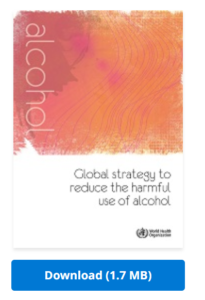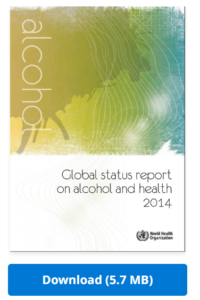WHO Alcohol Policy
Resolution WHA63.13 Global strategy to reduce the harmful use of alcohol
Overview
During the Sixty-third session of the World Health Assembly, held in Geneva in May 2010, the 193 Member States of WHO reached an historical consensus on a global strategy to reduce the harmful use of alcohol by adopted resolution WHA63.13. The adopted resolution and endorsed strategy gives guidance to both Member States and to the WHO Secretariat on ways to reduce the harmful use of alcohol. During the Sixty-third session of the World Health Assembly, held in Geneva in May 2010, the 193 Member States of WHO reached an historical consensus on a global strategy to reduce the harmful use of alcohol by adopted resolution WHA63.13. The adopted re solution and endorsed strategy gives guidance to both Member States and to the WHO Secretariat on ways to reduce the harmful use of alcohol.

Global strategy to reduce the harmful use of alcohol
During the Sixty-third session of the World Health Assembly, held in Geneva in May 2010, the 193 Member States of WHO reached an historical consensus on a global strategy to reduce the harmful use of alcohol by adopted resolution WHA63.13. The adopted resolution and endorsed strategy gives guidance to both Member States and to the WHO Secretariat on ways to reduce the harmful use of alcohol.
The vision behind the global strategy is improved health and social outcomes for individuals, families and communities, with considerably reduced morbidity and mortality due to harmful use of alcohol and their ens uing social consequences. It is envisaged that the global strategy will promote and support local, regional and global actions to prevent and reduce the harmful use of alcohol.
The global strategy aims to give guidance for action at all levels; to set priority areas for global action; and to recommend a portfolio of policy options and measures that could be considered for implementation and adjusted as appropriate at the national level, taking into account national circumstances, such as religious and cultural contexts, national public health priorities, as well as resources, capacities and capabilities.
https://www.who.int/publications/i/item/9789241599931

Global status report on alcohol and health – 2011
https://www.who.int/publications/i/item/global-status-report-on-alcohol-and-health-2011
Overview
The public health objective on alcohol of the World Health Organization (WHO) is to reduce the health burden caused by the harmful use of alcohol and, thereby, to save lives, reduce disease and prevent injuries. The hazardous and harmful use of alcohol is a major global contributing factor to death, disease and injury: to the drinker through health impacts, such as alcohol dependence, liver cirrhosis, cancers and injuries; and to others through the dangerous actions of intoxicated people, such as drink– driving and violence or through the impact of drinking on fetus and child development. The harmful use of alcohol results in approximately 2.5 million deaths each year, with a net loss of life of 2.25 million, taking into account the estimated benefi cial impact of low levels of alcohol use on some diseases in some population groups. Harmful drinking can also be very costly to communities and societies.

Global status report on alcohol and health – 2014
https://www.who.int/publications/i/item/global-status-report-on-alcohol-and-health-2014
Overview
The protection of the health of populations by preventing and reducing the harmful use of alcohol is a public health priority, and one of the objectives of the World Health Organization (WHO) is to reduce the health and social burden caused by the harmful use of alcohol.
The Global strategy to reduce the harmful use of alcohol defines “harmful use” as drinking that causes detrimental health and social consequences for the drinker, the people around the drinker and society at large, as well as the patterns of drinking that are associated with increased risk of adverse health outcomes. The vision of this strategy is to improve the health and social outcomes of individuals, families and communities, considerably reducing morbidity and mortality due to harmful use of alcohol and their ensuing social consequences (WHO, 2010a).

Global status report on alcohol and health – 2018
https://www.who.int/publications/i/item/9789241565639
Overview
WHO’s Global status report on alcohol and health 2018 presents a comprehensive picture of alcohol consumption and the disease burden attributable to alcohol worldwide by WHO regions and World Bank income groups. It also describes what countries are doing to reduce this burden. The report provides an overview of alcohol consumption and harms in relation to the UN Sustainable Development Goals (Chapter 1), presents global strategies, action plans and monitoring frameworks (Chapter 2), gives detailed information on: the consumption of alcohol in populations (Chapter 3); the health consequences of alcohol consumption (Chapter 4); and policy responses at national level (Chapter 5). In its final chapter 6, the imperative for reducing harmful use of alcohol in a public health perspective is presented. In addition, the report contains country profiles for WHO Member States and appendices with statistical annexes, a description of the data sources and methods used to produce the estimates and references.


